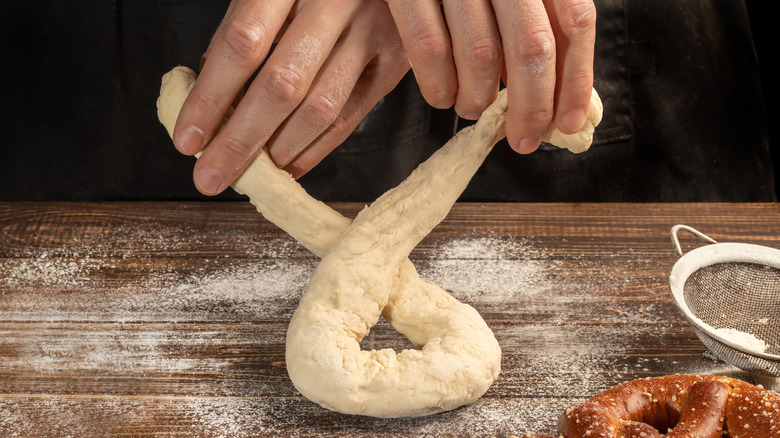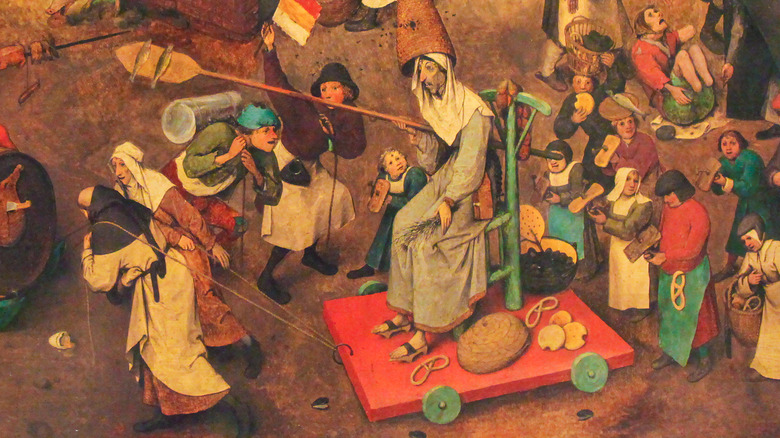The Unexpected Connection Between Pretzels And Religion
Ah, pretzels. You might associate the baked bread treat with the movie theater, a baseball game, or a fun day at the mall ... and a side cup of cheese sauce, of course. Or maybe you prefer the crunchy, snack-size version from a bag, dipped in chocolate for that sweet-and-salty combination.
This food has been around for centuries and is now part of other snacks such as Chex Mix and Reese's Popped Snack Mix. It's also available in different varieties, including pretzel bites/nuggets, sticks, and chips.
Food companies and consumers have both played a role in the evolution of the pretzel. But did you know that religion played a role in its creation, too? The origin of pretzels dates back to seventh-century Europe, according to History.com. Since then, pretzels have come to represent various religious aspects, especially in art, as they have been introduced to other parts of the world.
Early history of pretzels
There are several legends about the history of pretzels, but one of the most widely accepted ones involves a Catholic monk in an Italian monastery in 610 C.E. Author Sharon Hernes Silverman describes the account in her 2000 book, "Pennsylvania Snacks: A Guide to Food Factory Tours."
Per Silverman, the monk took a long, twisted strip of bread dough made from flour, water, and salt and overlapped the end pieces to resemble the arms of a praying child. At that time, members of certain Christian denominations crossed their arms in an "X" shape in front of their chest to pray. Many still recognize this custom today.
After the soft, doughy strips were baked, they were given to children as a reward for memorizing their prayers. This led some historians to believe pretzels were originally referred to as "pretiolas," which is Latin for "little rewards."
Others believe pretzels were originally called "bracellae," which means "little arms" in Latin, as they were made to look like the small arms of a child. The German word "bretzel" was derived from this Latin term in the mid 19th century, which was later translated to "pretzel" in English.
The religious symbolism of pretzels
As pretzels became more popular in Europe, they became a common go-to food during Lent in the seventh century, when strict fasting rules were in place (per Pretzels.com). And because of that knotted "X" shape that resembles folded arms in prayer, they also served as a reminder to pray and give penance for all who observe Lent.
This religious symbolism spread to other parts of the world over the years, which was commonly illustrated in artwork, such as Jan van Bijlert's "Pulling of the Pretzel." In 1440, St. Bartholomew was drawn with pretzels framing his image in the "Hours of Catherine of Cleves" prayer book. (Unfortunately, cheese sauce is not included in the depiction.) Pieter Bruegel's 1559 "The Fight Between Carnival and Lent" (pictured) also features pretzels as a traditional Lenten food. You can even find depictions of The Last Supper that feature pretzels, instead of the traditional unleavened bread.
Even the pretzel's hollow sections held religious symbolism. The three circles were believed to symbolize the Trinity (the Father, the Son, and the Holy Spirit), according to a 1988 report from The New York Times. Now that you know the historical connection between pretzels and religion, you'll have a fun fact to share with your friends on the next National Pretzel Day. You're welcome.


